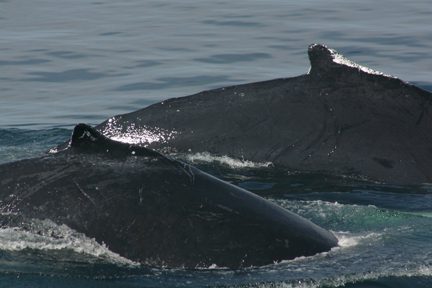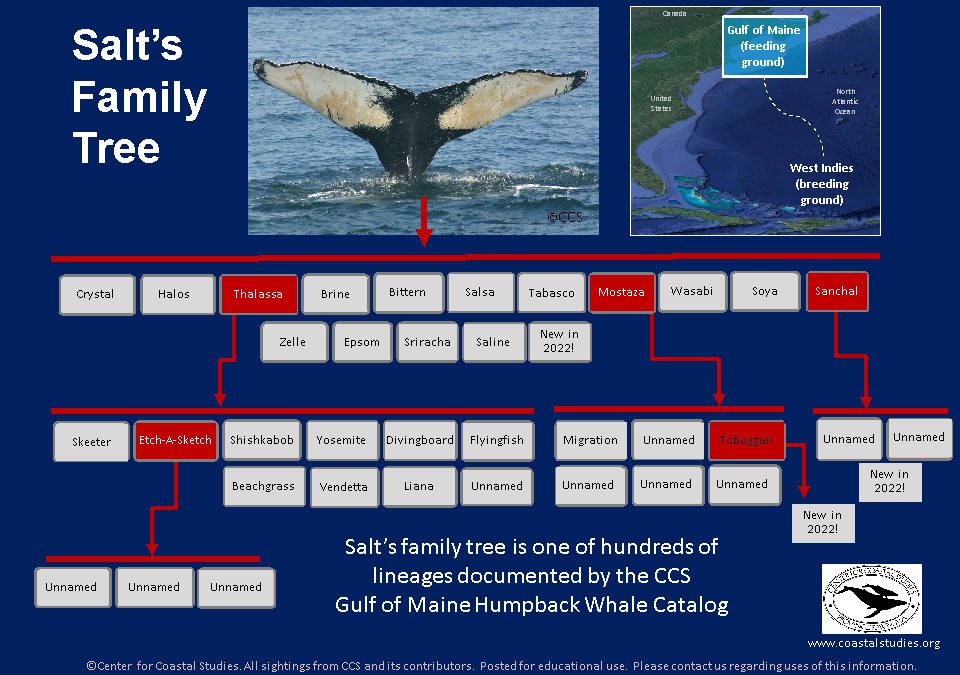Meet “Salt”

Dorsal fin of Salt (right) and her 2006 calf Soya (left). Note the white scarring on Salt’s dorsal fin that seems like a coating of salt.
A humpback whale named Salt has played an important role in our research. One of our staff and founders, Dr. Charles “Stormy” Mayo, was the first scientist to observe her in the mid-1970s. The sighting occurred when Stormy joined Aaron Avellar and the rest of the Dolphin Fleet crew in their first trips of commercial whale watching. We have since resighted and studied Salt more than any other individual whale, documenting her in all but one year since her first sighting. Many consider her the ‘Grande Dame’ of Stellwagen Bank because of the frequency with which she is seen here. Studies of Salt and other humpback whales in this region have formed the basis of our Gulf of Maine humpback whale catalog and database. In addition to her extensive sighting history in the Gulf of Maine, we have also observed Salt on her breeding ground during our research in the West Indies.
In that first year, Aaron Avellar bestowed names on “Salt” and her companion “Pepper” based on the differences that they observed in their dorsal fins. Salt was named for white scarring on her dorsal fin that looks like a layer of salt, while “Pepper” had a black dorsal fin without scarring. What began on a whale watch boat (and later a small group in Stormy’s living room in Provincetown) is now a long-standing community tradition in this region. The Gulf of Maine humpback whale naming is organized and moderated by CCS (previously along with our colleagues at the former Whale Center of New England). However, Aaron’s family still has the unique honor of naming all of Salt’s calves.
 Long-term studies provide critical information for humpback whale science and conservation. Our studies of Salt and other members of this population have helped to improve understanding of humpback whale biology, population status and threats. As just one example, genetic samples that we collected from Salt and her calves in the early 1990s proved for the first time that female humpbacks are promiscuous (their calves do not have the same fathers). The first humpback whale genome has been sequenced from a skin sample of this amazing individual. Decades after our first sighting, Salt continues to teach us about the inner world of the humpback whale, and her genome is even helping us to understand cancer prevention mechanisms more generally. For more details, see our scientific publications.
Long-term studies provide critical information for humpback whale science and conservation. Our studies of Salt and other members of this population have helped to improve understanding of humpback whale biology, population status and threats. As just one example, genetic samples that we collected from Salt and her calves in the early 1990s proved for the first time that female humpbacks are promiscuous (their calves do not have the same fathers). The first humpback whale genome has been sequenced from a skin sample of this amazing individual. Decades after our first sighting, Salt continues to teach us about the inner world of the humpback whale, and her genome is even helping us to understand cancer prevention mechanisms more generally. For more details, see our scientific publications.
Data and information provided for educational purposes. Please contact us for permission in advance of use.


